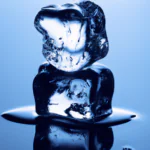Grass growth heavily depends on temperature, with soil temperature playing a crucial role. A warmer soil speeds up grass growth by enabling chemical processes that drive plant growth to work faster and more efficiently. On the other hand, if the soil is too hot, water is lost too quickly through evaporation, drying out the plant and slowing its growth. It is essential to maintain the optimum soil temperature for cool season grasses, which is between 18-24 degrees Celsius.
The growth of the grass plant is activated at different temperatures as different processes occur at different temperature ranges. It is important to note that soil temperature is different from air temperature. The soil takes a longer time to change temperature; during spring, the soil may be cold from winter and consequently pose problems for spring scarification and lawn repairing.
In contrast, in autumn, the soil retains a lot of heat, aiding seed germination and enabling the grass to absorb valuable nutrients from autumn fertilisation. Understanding the soil temperature for grass treatment at the right time for optimum growth is essential.
Understanding the relationship between temperature and grass growth is vital for healthy lawn development. While temperature plays a critical role in the growth process, the key takeaway is that maintaining the optimum soil temperature is crucial for optimal grass growth.
Table of Contents
The Minimum Temperature for Grass to Survive: Find the General Temperature Range for Grass Survival
Many homeowners wonder what the minimum temperature is for grass to survive. The answer is simple: the minimum temperature for grass to survive is 50°F. If the temperature goes below 50°F, the grass may struggle to grow, and if the temperature drops below freezing, there is a risk of permanent damage, and the grass may not grow back.
Planting grass seed in soil temperature below 50°F is too cold for grass seed. Therefore, waiting until the weather is at the correct temperature is important. Cool-season grass seed needs a soil temperature of 50 and no more than 65°F to germinate properly. If the temperature is too low, the seed may not grow; if it’s too high, the heat could prevent germination.
It is recommended to plant cool-season grass seed in Fall instead of Spring. Specifically, September is the best month, followed by October. Planting in the Fall allows the grass to establish roots before the hot summer months. If planted in spring, the young grass may not have enough time to establish before the summer heat arrives, putting it in danger of drying out and dying.
Weather patterns can also play a major role in grass survival. The heat could also prevent germination if temperatures get too hot too quickly. In hot climates, it is important to plant grass seeds when there is more shade or cooler temperatures to avoid any negative impact on the seed’s ability to grow.
In short:
- The minimum temperature for grass to survive is 50°F.
- Cool-season grass seed needs a soil temperature between 50 and 65°F.
- Plant cool-season grass in the Fall, specifically in September or October.
- Weather patterns can affect grass seed growth.
Different Grass Types and Their Temperature Ranges
Different grass types have different temperature ranges at which they thrive. If you want to keep your lawn healthy and looking good, it’s important to choose grass types best suited to your area’s climate and temperature range. Here are some of the most common types of grass and their optimal temperature ranges:
- Warm season grass: This type of grass grows best when the temperatures range from 80 to 95 degrees Fahrenheit. It is typically found in the gulf coast’s humid zones and the southwest’s arid desert. Grass species that thrive in humid weather include Bahiagrass, St. Augustine and Zoysia. Bermudagrass is typically found in the arid regions of Texas and the southwest because of its resiliency in tough drought conditions. Warm-season grass usually becomes dormant and loses its lush appearance when soil temperatures drop below 65 degrees.
- Cool season grass: These grasses typically do well in the humid and cooler parts of the Northeast, Midwest, and Pacific Northwest. These grass species include Rye, Bluegrass, Fescue and Wheatgrass, which grow best in temperatures sitting between 65 to 75 degrees.
- Transition zone: This is a band of states ranging from Virginia across to parts of southern California where the optimal weather conditions for either type of grass aren’t prevalent. Typically, outdoor experts use cool season grass in this area of the country or a mixture of the two. Still, recent biological advancements have seen new types of warm season grass like Geo Zoysia and Latitude 36 Bermuda, which have become more cold tolerant.
Knowing which type of grass is best suited to your location can make a huge difference in the way your lawn looks and performs. It’s important to note that there are many different cultivars within each type of grass, each with its own set of characteristics that make it more or less suitable for certain conditions. Doing a little research and consulting with a lawn care expert can determine the best grass type for your location and ensure that your lawn stays green and healthy throughout the year.
Effects of Cold Temperature on Grass Growth and Health
If you live in an area with cold temperatures, it’s essential to know the effects of cold temperature on grass. Freezing temperatures harm any grass, and your turf is even more susceptible to damage if you don’t take care to prep your lawn in the fall through fertilizing and watering.
When frost and snow arrive, your grass may soon turn brown and look dead. However, your grass is not dead. It has just gone dormant for the season. When your grass turns brown, it conserves water and nutrients to help you get through the winter and spring. Low humidity levels and constant winds can affect your lawn by removing necessary moisture, which results in desiccation or drying out of your grass. This can cause the grass to die off, but it shouldn’t be so much that it becomes a serious problem.
Some “winter grasses,” including fescue and some ryegrass, may continue to blossom and grow even during these harsh winter conditions. You can take preventive measures to avoid this condition, but its formation can be hard to predict. Fortunately, most snow mold will not have a long-lasting effect on your lawn.
- Freezing temperatures have a detrimental effect on any grass
- Low humidity levels and constant winds can affect your lawn by removing necessary moisture
- Some “winter grasses,” including fescue and some ryegrass, may continue to blossom and grow even during these harsh winter conditions
- Fortunately, most snow mold is not going to have a long-lasting effect on your lawn
Signs of Cold Stress in Grass
If you notice your grass looking wilted, with discolored or mushy foliage, or a loose root ball, it may suffer from cold shock. Cold shock occurs when grass is exposed to temperatures below its native grow zone. Like other plants, grass can be sensitive to cold weather.
To prevent cold shock in grass, choosing varieties rated for the local grow zone is important. This helps ensure that the grass can tolerate the common temperatures in your area. Providing shelter from cold winds can also help protect the grass from cold stress.
According to experts from the University of Illinois, cold weather can significantly impact grass. They recommend avoiding fertilizing the grass in the fall and instead focusing on building up root systems. This can help the grass better endure the cold temperatures of winter. Once spring arrives, it may be necessary to reseed or overseed any grass areas damaged by the cold.
The Lawn Institute, a non-profit organization that promotes the benefits of natural turfgrass lawns, also recommends proper lawn care to prevent cold stress in grass. They advise mowing the grass to the correct height, which can vary depending on the type of grass, to avoid putting undue stress on the roots. Additionally, they suggest not overwatering the grass, which can increase the risk of frost damage.
- Choose grass varieties rated for the local grow zone
- Provide shelter from cold winds
- Avoid fertilizing in the fall and focus on building up root systems
- Mow the grass to the correct height
- Do not overwater the grass
How To Protect Grass From Cold Temperatures
Cold temperatures can be harsh on grass, causing frost damage that can kill or damage the turf. If you want to protect your lawn during cold weather, you can take some simple steps to keep it healthy and growing strong. Here are some tips to help you with that:
- Avoid walking or driving on the lawn during frosty weather: Walking or driving on the grass can cause damage to the turf when it is fragile from frost, especially when it is frozen. If you must go on the lawn, stick to paths or other designated areas.
- Keep pets off the lawn: Just like people, pets can cause damage to the lawn during frosty weather. Their urine can cause burn spots on the turf, which can be more severe when the grass is frozen.
- Deep watering the evening before a frost may sound surprising, but deep watering the evening before a frost can help protect the grass. That’s because evaporation creates warmth around the grass blades, preventing frost damage.
- Insulating young or newly planted grass with peat moss or a light bedsheet: Covering the grass can help insulate it from frost and keep it warm. Peat moss or a light bedsheet can provide a breathable barrier that will not damage the grass.
- Avoid using plastic tarps or straw for insulation: While plastic tarps and straw are both good insulators, they can damage the grass by blocking necessary sunlight and fresh air. They can also cause a moisture buildup, which can lead to fungal growth.
You can protect your grass from cold temperatures and frost damage by following simple steps. Remember to be gentle with your lawn during cold weather; it will stay healthy and green all year round.
Cold-Tolerant Grass Varieties for Year-Round Greenery
Look no further if you’re looking for grass varieties that can withstand cold weather. Here is a list of some of the best cold-tolerant grass varieties that you can grow in winter: Kentucky Bluegrass, Improved Tall Fescue, Perennial Ryegrass, Velvet Bentgrass, Chewings Red Fescue, Prostrate Meadow, Creeping Bentgrass, Browntop/Colonial Bentgrass, Rough Meadow Grass, and Annual Meadow Grass.
Kentucky Bluegrass is a popular choice for cool-season grasses because of its fine texture and beautiful emerald-green color. It is also one of the most cold-tolerant grasses and can survive extreme temperatures. Improved Tall Fescue is another excellent choice for a year-round green lawn. It is drought-resistant and can withstand heavy foot traffic. Perennial Ryegrass is known for its quick growth and tolerance to cold weather. It is perfect for overseeding existing lawns. Velvet Bentgrass is a low-maintenance grass that thrives during winter months, making it a suitable option for golf courses and parks.
Chewings Red Fescue is a fine-textured grass that grows well in colder areas. It tolerates drought and shade, making it an ideal choice for lawns with partial shade. Prostrate Meadow is a creeping grass perfect for growing in colder regions. It is resistant to both drought and disease, making it a popular choice for sports fields. Creeping Bentgrass has a low-growing habit and is well-suited for golf courses and lawns. Browntop/Colonial Bentgrass is a robust grass perfect for colder regions. It is resistant to diseases and can withstand heavy foot traffic. Rough Meadow Grass and Annual Meadow Grass are excellent options for cold-tolerant grass varieties. They are both fast-growing and can quickly establish roots in cold weather conditions.
When choosing a cold-tolerant grass variety, it’s essential to consider your local climatic conditions and geographical location. Some grass species are more resistant to winter diseases and snow molds than others. With the right grass, you can enjoy a lush green lawn year-round, even in cold weather, without compromising quality and appearance.
Lawn Care Tips for Cold Temperatures
Winter is approaching, and it’s time to start preparing your lawn for the colder temperatures. Whether your yard is covered in snow or not, there are several lawn care tips you should keep in mind to ensure your grass stays healthy throughout winter.
Tips for Winter Lawn Care (Snow-Covered):
- Supply Adequate Nitrogen: Before winter hits, fertilize your lawn to supply adequate nitrogen to the grass plants. This will give them enough carbohydrates to use throughout the year’s coldest months. Doing this in the fall is important so the grass has time to absorb the nutrients.
- Cut the Grass Shorter: On your final season cut, cut the grass shorter to decrease the potential for snow mold buildup. Snow mold can affect your lawn in the spring and cause damage to the grass. By cutting the grass short, snow will be less likely to accumulate on top of it, reducing the risk of snow mold.
- Use Fallen Leaves: Don’t let fallen leaves go to waste. They can improve your lawn’s soil health by mulching the leaves into the grass. The leaves will break down over time and provide nutrients for your lawn. Some winter leaves can also help insulate the soil, protecting the grass roots from freezing.
- Aerate Your Lawn: Before winter hits, aerate your lawn. This will decrease compaction and increase infiltration of water into the soil. Compacted soil can lead to drainage problems and damage to the grassroots. Aerating your lawn’ll create a healthy environment for your grass to grow in during winter.
- Spray Pre-Emergents: To prevent fall-germinating weeds like poa trivialis, spray pre-emergents on your lawn. Poa trivialis is a grassy weed that spreads quickly and can easily outrun your lawn in shady areas. Spraying pre-emergents’ll prevent these weeds from taking over your lawn in the winter.
- Clean Off Your Lawn: After your final mowing, make sure to clean off your lawn. Leaves and sticks left on the lawn can block the light and trap moisture, leading to snow mold and other fungus issues. By cleaning off your lawn, you’ll keep it healthy and free from pests and diseases.
Tips for Winter Lawn Care (Little or No Snow):
- Keep Mowing: Keep mowing your lawn until the grass stops growing. This will push the growth horizontally and thicken up to crowd out weeds. Mowing regularly will also prevent your grass from getting too long and falling over, which can lead to snow mold problems later on.
- Water Your Lawn: If your lawn isn’t getting at least a half-inch of water every other week, water it. Keeping your grass hydrated will prevent it from losing the turf system over winter. It’s important to ensure the soil is not frozen before watering, as this can cause damage to the grassroots.
- Test Your Soil: Check your soil’s nutrient levels and plan for next season. Testing your soil will help you determine what nutrients your grass needs so that you can provide it with the necessary fertilizers and other supplements in the spring. Healthy soil will provide the foundation for a healthy lawn.
- Maintain Equipment: Make sure your lawn equipment is in peak condition. Regular lawn mower maintenance and other equipment will ensure they are working properly and won’t break down during the winter. It’s also important to store your equipment properly, keeping it out of the elements and away from moisture.




